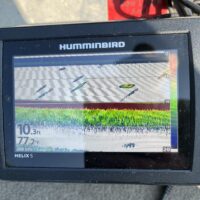Sonar is a cone.
Narrowest at the transducer and widest on the lake bottom.
I’ll explain the classic fish ‘arc’ first.
As a fish passes into the edge of sonar it is furthest from the transducer. As that fish nears the center of the cone it is nearest the transducer. As it leaves and finally exits the cone it is again the furthest. What the graph shows as a result is an ‘arc’. It is simple measuring the distance over time of a passing by object.
Thickness of arc at the center of arc when directly below sonar is the best indicator of fish size. However not everything passes directly through the center of your cone. Some only visit the edge. Two fish of same size one through center of cone one on outer edge will have different Thickness on the graph and the one further will appear lower on the graph.
So that’s how sonar works.
A fish can pass by a stationary boat. A boat can pass a stationary fish. A fish can swim alongside with you for a period of time and a fish can quickly swim through as well. Length of return is generally immaterial information. It tells you how long something was within your sonar cone. It tells you nothing more. Not size of fish…nuttin. A fish swimming under your boat at your speed will show a line continuing across the screen. That don’t mean it is a long fish.
OK so why don’t you have an ‘arc’.
It is likely that your sonar is angled forward or aft. Level it and you’ll see those angled lines flatten out. But I do see some flat returns.
In reality at 10′ your cone is very small. I like to turn up sensitivity so there is a little clutter on the screen.
May be a bunch of the same sizes fish. May be some variety of size. There’s no magic interpretation given a screenshot of a graph. Bubbles too, sure why not.
You might find it useful to spend some time learning the sonar technology. Google humminbird image interpretation from BBC boards and read on. Wealth of info.
